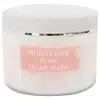What's inside
What's inside
 Key Ingredients
Key Ingredients

 Benefits
Benefits

 Concerns
Concerns

 Ingredients Side-by-side
Ingredients Side-by-side

Oryza Sativa Bran Water
MaskingWater
Skin ConditioningDipropylene Glycol
HumectantHydrogenated Polydecene
Emollient1,2-Hexanediol
Skin ConditioningGlycerin
HumectantNiacinamide
SmoothingAcrylates Copolymer
Ceratonia Siliqua Gum
EmollientXanthan Gum
EmulsifyingCarrageenan
Hydroxyacetophenone
AntioxidantOryza Sativa Extract
AbsorbentSucrose
HumectantAllantoin
Skin ConditioningPotassium Chloride
Oryza Sativa Hull Powder
AbrasiveSodium Polyacrylate
AbsorbentDipotassium Glycyrrhizate
HumectantCellulose Gum
Emulsion StabilisingGellan Gum
Caprylyl Glycol
EmollientAdenosine
Skin ConditioningButylene Glycol
HumectantPanthenol
Skin ConditioningEthylhexylglycerin
Skin ConditioningSodium Phytate
Iron Oxides
Soluble Collagen
HumectantSodium Hyaluronate
HumectantCI 77491
Cosmetic ColorantHydroxypropyltrimonium Hyaluronate
Phytosphingosine
Skin ConditioningOryza Sativa Seed Protein
AntioxidantHydrolyzed Rice Protein
Skin ConditioningCeramide NP
Skin ConditioningSodium Acetylated Hyaluronate
HumectantHydrolyzed Hyaluronic Acid
HumectantHyaluronic Acid
HumectantSodium Hyaluronate Crosspolymer
HumectantHydrolyzed Sodium Hyaluronate
Skin ConditioningPotassium Hyaluronate
Skin ConditioningOryza Sativa Bran Water, Water, Dipropylene Glycol, Hydrogenated Polydecene, 1,2-Hexanediol, Glycerin, Niacinamide, Acrylates Copolymer, Ceratonia Siliqua Gum, Xanthan Gum, Carrageenan, Hydroxyacetophenone, Oryza Sativa Extract, Sucrose, Allantoin, Potassium Chloride, Oryza Sativa Hull Powder, Sodium Polyacrylate, Dipotassium Glycyrrhizate, Cellulose Gum, Gellan Gum, Caprylyl Glycol, Adenosine, Butylene Glycol, Panthenol, Ethylhexylglycerin, Sodium Phytate, Iron Oxides, Soluble Collagen, Sodium Hyaluronate, CI 77491, Hydroxypropyltrimonium Hyaluronate, Phytosphingosine, Oryza Sativa Seed Protein, Hydrolyzed Rice Protein, Ceramide NP, Sodium Acetylated Hyaluronate, Hydrolyzed Hyaluronic Acid, Hyaluronic Acid, Sodium Hyaluronate Crosspolymer, Hydrolyzed Sodium Hyaluronate, Potassium Hyaluronate
Water
Skin ConditioningCarbomer
Emulsion StabilisingPropanediol
SolventAcrylates/C10-30 Alkyl Acrylate Crosspolymer
Emulsion StabilisingHydrolyzed Adansonia Digitata Extract
EmollientHoney Extract
HumectantHyaluronic Acid
HumectantTriethanolamine
BufferingChlorphenesin
AntimicrobialPPG-1-PEG-9 Lauryl Glycol Ether
EmulsifyingPEG-40 Hydrogenated Castor Oil
EmulsifyingCoceth-7
EmulsifyingRosa Gallica Flower Powder
Skin ConditioningParfum
MaskingAscorbic Acid
AntioxidantAloe Barbadensis Leaf Extract
EmollientRuscus Aculeatus Root Extract
AstringentHydrolyzed Yeast Protein
Skin ConditioningChondrus Crispus Extract
Skin ConditioningButylene Glycol
HumectantAmmonium Glycyrrhizate
MaskingPanthenol
Skin ConditioningEscin
TonicCentella Asiatica Extract
CleansingCalendula Officinalis Flower Extract
MaskingSodium Hyaluronate
HumectantWater, Carbomer, Propanediol, Acrylates/C10-30 Alkyl Acrylate Crosspolymer, Hydrolyzed Adansonia Digitata Extract, Honey Extract, Hyaluronic Acid, Triethanolamine, Chlorphenesin, PPG-1-PEG-9 Lauryl Glycol Ether, PEG-40 Hydrogenated Castor Oil, Coceth-7, Rosa Gallica Flower Powder, Parfum, Ascorbic Acid, Aloe Barbadensis Leaf Extract, Ruscus Aculeatus Root Extract, Hydrolyzed Yeast Protein, Chondrus Crispus Extract, Butylene Glycol, Ammonium Glycyrrhizate, Panthenol, Escin, Centella Asiatica Extract, Calendula Officinalis Flower Extract, Sodium Hyaluronate
Ingredients Explained
These ingredients are found in both products.
Ingredients higher up in an ingredient list are typically present in a larger amount.
Butylene Glycol (or BG) is used within cosmetic products for a few different reasons:
Overall, Butylene Glycol is a safe and well-rounded ingredient that works well with other ingredients.
Though this ingredient works well with most skin types, some people with sensitive skin may experience a reaction such as allergic rashes, closed comedones, or itchiness.
Learn more about Butylene GlycolHyaluronic acid is naturally found in healthy skin. It is a humectant, meaning it draws moisture to your skin.
This ingredient helps hydrate, soothe, and protect the skin.
What makes hyaluronic acid so hydrating? It has the capacity to bind or hold large amounts of water.
Fun fact: It is already naturally found in our bodies, such as the fluids of our eyes and our joints.
Studies find this ingredient to have anti-inflammatory and anti-microbial properties. This can help speed up wound-healing.
Hyaluronic acid can be irritating if the molecule has a low-molecular weight, or if the molecules are small.
One study found low-molecular weight hyaluronic acid to be pro-inflammatory, meaning some people may experience irritation. This is because our bodies use hyaluronic acid in the wound-healing process to signal to our bodies, via irritation, that something needs healing.
The same study found high-molecular weight hyaluronic acid to be anti-inflammatory.
These are some other common types of Hyaluronic Acid:
Learn more about Hyaluronic AcidPanthenol is a common ingredient that helps hydrate and soothe the skin. It is found naturally in our skin and hair.
There are two forms of panthenol: D and L.
D-panthenol is also known as dexpanthenol. Most cosmetics use dexpanthenol or a mixture of D and L-panthenol.
Panthenol is famous due to its ability to go deeper into the skin's layers. Using this ingredient has numerous pros (and no cons):
Like hyaluronic acid, panthenol is a humectant. Humectants are able to bind and hold large amounts of water to keep skin hydrated.
This ingredient works well for wound healing. It works by increasing tissue in the wound and helps close open wounds.
Once oxidized, panthenol converts to pantothenic acid. Panthothenic acid is found in all living cells.
This ingredient is also referred to as pro-vitamin B5.
Learn more about PanthenolSodium Hyaluronate is hyaluronic acid's salt form. It is commonly derived from the sodium salt of hyaluronic acid.
Like hyaluronic acid, it is great at holding water and acts as a humectant. This makes it a great skin hydrating ingredient.
Sodium Hyaluronate is naturally occurring in our bodies and is mostly found in eye fluid and joints.
These are some other common types of Hyaluronic Acid:
Learn more about Sodium HyaluronateWater. It's the most common cosmetic ingredient of all. You'll usually see it at the top of ingredient lists, meaning that it makes up the largest part of the product.
So why is it so popular? Water most often acts as a solvent - this means that it helps dissolve other ingredients into the formulation.
You'll also recognize water as that liquid we all need to stay alive. If you see this, drink a glass of water. Stay hydrated!
Learn more about Water